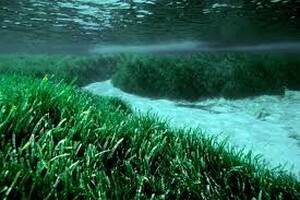
The tiny holes humans tear in the ocean floor on an almost daily basis have major consequences for global warming for generations, a leading Deakin University scientist has found.

But Dr Peter Macreadie, an Australian Research Council Discovery Early Career Researcher Award Fellow investigating the field of blue carbon, argues that some simple solutions can be found under the guidance of science.
Dr Macreadie, from Deakin's Centre for Integrative Ecology within the School of Life and Environmental Sciences, is the lead author on Losses and recovery of organic carbon from a seagrass ecosystem following disturbance, published in today's leading scientific journal Proceedings of the Royal Society B. The research team has uncovered new evidence to show that disturbing seagrasses in coastal environments can release ancient carbon and reduce the capacity of seagrass ecosystems to offset carbon emissions into the future.
The problem was exacerbated by the often lengthy time it took for seagrasses to regrow once disturbed. Dr Macreadie said seagrass disturbance occurred around Australia and the world on a daily basis due to coastal development. It's estimated that since the 1980s we've been losing two football fields of seagrass area per hour. He said that on a positive note, the new research showed that seagrass areas that had recovered were once again capturing and storing carbon. "While I'm not surprised by this, as we've known for some time now that seagrasses are among the most powerful carbon sinks on the planet, this is important empirical evidence of the need to restore denuded seagrass ecosystems rather than wait and hope they recover," he said.
Dr Macreadie recommended better regulations to protect seagrasses, and, importantly, to make those who destroy seagrasses pay the realistic price of their damage. "Loss of carbon and carbon sequestration capacity has never been factored monetarily before," he said. "The second thing we need to do is turn our attention to restoration. In some areas we need to re–plant seagrass, while in other areas we need to improve our catchments to control upstream processes that negatively affect seagrass recovery – such as sediment and nutrient runoff. Seagrasses are among earth's most efficient and long-term carbon sinks, but coastal development has threatened their capacity.
Just as one example, the seagrass destroyed from a series of holes between 10 metres and 30 metres wide, etched into the bottom of waters between four and six metres deep in the 1960s when Australia tested the suitability for a nuclear testing facility at Jervis Bay in NSW, has not yet regrown. We found that soil carbon stocks in this area declined by 72 per cent after the disturbance, which, according to radiocarbon dating, had taken hundreds to thousands of years to accumulate. "That was more than 50 years ago, but in just the last five years we have started to learn exactly how valuable our seagrasses are for storing carbon.
"Seagrasses sequester carbon at a rate 35-times faster than tropical rainforests, which they bury within soils for millennial time-scales. However, coastal development poses a major threat to the capacity of seagrasses to act as carbon sinks," he said. Already 29 per cent of the world's seagrasses have been destroyed, raising concern that degraded seagrass meadows could leak vast amounts of ancient carbon back out into the atmosphere. Sadly, we are still behind when it comes to developing a strategy to preserve this blue carbon.
There are uproars in our communities when forests are destroyed, and rightly so, but seagrasses are torn out of the ocean every single day and rarely anyone objects. "Our coastal systems help sustain human well-being but if we don't do something to preserve them then our future generations will miss out on all the wonderful ecosystem services that they provide, such as fisheries, clear waters, erosion control, and carbon sequestration
http://phys.org/news/2015-10-scientist-global-problems-seagrass-loss.html
